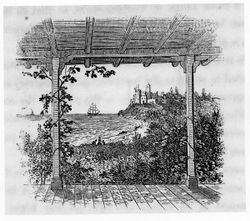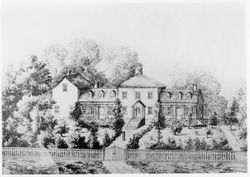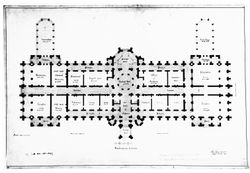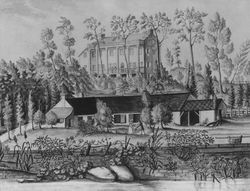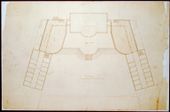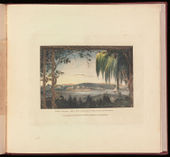Piazza
(Piazer, Piazzia)
History
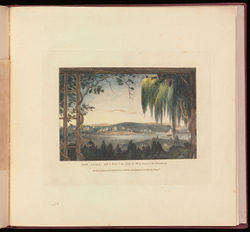
Several words were used synonymously to describe covered walks or spaces supported by columns or piers and attached to, or to part of, a building. This architectural feature spoke to the interrelatedness of architecture and gardens, a relationship that grew out of the romantic interest in landscape characterizing the aesthetics of the eighteenth and nineteenth centuries.
Two images exemplify the importance of the piazza, veranda, porch, and portico in creating and framing views of the garden and landscape. The first is a drawing of York Island, Long Island, by William Russell Birch (1808), who explained that the view was taken from the piazza, a place from which one could see "innumerable seats, spreading over an extensive country which glittered as the sun arose" [Fig. 1]. The second is from A. J. Downing's book on wooden picturesque houses, The Architecture of Country Houses (1850) [Fig. 2]. Both illustrated views from the bracketed piazza, or veranda, as Downing preferred to call it, out to the distant prospect.
Various treatises used all of these terms interchangeably in their definitions. Alexander Jackson Davis and Downing also used the term 'umbrage' to refer to the same feature on a house, implying a place of shade.[1] Mary Elizabeth Latrobe mentioned that in New Orleans the piazza was known as the gallery. Contrasting usage of these words sometimes could offer distinctions. Rev. Manasseh Cutler, for example, in his description of Monticello, said that the term "portico" refers to smaller entrance porches and the term "piazza" to extended covered walkways stretching perpendicularly from the porticos. For the purposes of this essay, each of the four key terms will be described in turn, highlighting any specific meanings that have been attributed to them.
In 1828, Frances Milton Trollope, the acerbic critic of American art and architecture, described the piazza as a "luxury almost universal in the country houses of America." Indeed it was a feature found throughout the colonies and dates from the late eighteenth to the mid-nineteenth centuries. From Massachusetts to the lower Mississippi Valley, examples are found on both private and public buildings. The feature was adapted to various styles with appropriate detailing and ornamentation. The piazza was a projecting porch or connecting passage that was identifiable in neoclassical plantation houses in the South, as well as in the Gothic revival suburban cottages of New Jersey and Pennsylvania. There were countless variations ranging from the simple wooden post-and-lintel type, to stone-arched piazzas depicted by Batty Langley [Fig. 3] and mentioned in 1839 at Laurel Hill Cemetery in Philadelphia.
In texts and images related to American gardens of the period under study, although several imported treatises traced "piazza" back to covered walkways that surrounded the square, the term has not been associated with the Italian term for a medieval or renaissance square. It was generally described as two related but somewhat distinctive appendages to buildings. First, the piazza was attached porch-like to a façade so that three sides of the piazza projected out from the building [Fig. 4], or the sides were recessed into the structure, as on the main façade of the U.S. Naval Asylum in Philadelphia [Fig. 5]. At other times it appeared on more than one façade [Fig. 6]. In New Orleans one house was described as having piazzas on all four sides. Both one- and two-story piazzas were also built. Second, "piazza" also referred to a covered walkway embedded between two buildings and acting as a connecting link. A single- or even double-height piazza, such as that described in 1799 on a property in Richmond, Va., provided either an entrance or transition space from interior architecture to exterior space. In the case of the University of Virginia, piazzas linked the entire range of houses around the lawn, and they served as transitional spaces leading to the lawn [Fig. 7].
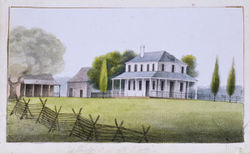
The piazza's basic structure consisted of a roof supported by pillars or columns. A piazza might be walled on each side with Venetian blinds or, as Harriet Martineau described one in 1835, "draperied with vines." Flooring was stone, flag, wooden planks, or gravel. The roof was generally either flat or peaked. James E. Teschemacher (1835), however, described and illustrated a piazza with a concave roof formed of painted floor cloth fastened on wooden rafters, which were supported by wooden arches. Several images depict the piazza at ground level opening directly out into the landscape. Some examples, however, describe broad and spacious flights of stairs leading from the piazza and 'descending into the garden.' At Thomas Jefferson's Monticello (Charlottesville) and Poplar Forest (Bedford County, Va.), the piazzas had no immediate access to the ground but instead were raised, balcony-like structures overlooking the garden. Even if not a physical link, the visual connection to the exterior remained critical to the function of this feature.
The nineteenth-century architect William H. Ranlett, who used them often in his residential design, praised piazzas for their "very expressive" purpose. They functioned as sitting areas that were furnished with couches, chairs, and sometimes tables where one could take a meal. They were used to provide a place for walking or sitting and enjoying the breeze, shade and coolness; they also served to keep the sun from warming the interior of the house. Since the feature was designed to provide views in addition to protection from the sun, orientation of the piazza had to be planned with regard to the sun and surrounding environment. At Hyde Park, a visitor in 1830 mentioned that one piazza was open to the Hudson River and the other looked over a beautiful lawn, suggesting that the view dictated where the piazzas might be located.
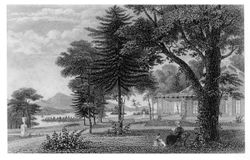
Ranlett was emphatic when he decreed that a "dwelling should always have one or more of them [piazzas]." He regarded the absence of a piazza on a new house an indication of ignorance, niggardliness, and narrow- minded views. Downing (1850) went so far as to proclaim the lack of a piazza or veranda in any but the most utilitarian structure as "unphilosophical and false in taste!" He claimed that it was a resting place, lounging spot, and place of social resort of the whole family across nearly the entire extent of the United States [Fig. 8].
Appearing only in the mid-nineteenth century in treatise literature with any frequency, the term "veranda" (also spelled verandah) was used in 1748 in Pehr Kalm's Travels in North America, in which he described small balconies or porches on houses.[2] Many visual and textual examples indicate that veranda served as an intermediary space between a house and its garden. Downing described it as an overhanging or low roof supported by an open colonnade or framework. He recommended that it have a gravel or wooden surface rising six to eight inches above the surrounding ground. Climbing plants often covered verandas. Some writers refer to arbor-verandas and also mention the latticework that provided screening and support for climbing plants. Ornamental brackets and bargeboards also added to the decorations of the veranda.
The term was, as mentioned, often used interchangeably with "porch," "portico," and "piazza." Ranlett sometimes distinguished between the two, using "piazza" for a projecting roof and "veranda" for an overhanging roof. Downing used the term "porch" to identify that part of the veranda where steps led from the ground to the entryway. He also used the term "pavilion" synonymously with "veranda".
Downing (1850) expounded at length on the meaning of the veranda, which he saw as a truly American feature not found in European architecture.[3] Always concerned with identifying a national style, he believed that the veranda, in addition to providing shade and transitional zone from house to garden, was not simply ornamental but useful and "connected with the life of the owner of the cottage." Its presence expressed the ownership of a family exhibiting rural taste and a love of [picturesque] character, a family "at home in the country."
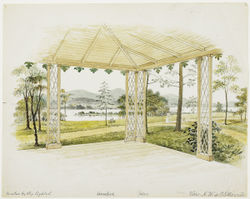
Although the veranda was an architectural feature found in the colonial and early national periods, it became a key component of asymmetrical picturesque design for both landscape and architecture in the 1840s.[4] Many illustrations for house pattern books by Downing and his followers depicted plans and elevations in various romantic styles that feature the veranda as an element in a new spatial organization that experimented with the interweaving of interior and exterior space. In his Treatise (1849) Downing wrote, "architectural beauty must be considered conjointly with the beauty of the landscape or situation," and "if properly designed and constructed . . . will even serve to impress a character on the surrounding landscape."[5] That the frontispiece to his Treatise illustrated the veranda at Blithewood underscores the importance of this theoretical stance. Another drawing of Blithewood [Fig. 9] by Alexander Jackson Davis presented, from the house and through the semi-enclosed space of the veranda, the view of the landscape toward the river, exemplifying the interpenetration of space that became for Davis and Downing an important characteristic of their architecture. Architectural historians have written about the veranda as a major component in picturesque architecture and a mark of distinction between American and English houses of the Gothic revival.[6]

The term "porch," as the 1828 dictionary entry by Noah Webster indicates, refers to a roofed architectural element often supported by columns or piers, either attached to a building or existing as an independent garden structure. During the colonial and early Republic periods three kinds of porches were evident throughout America. First, the porch was either an open or enclosed projecting roofed area of a building that sheltered a doorway or entrance [Fig. 10]. Since most gardens were situated next to the house, a porch was often a point of access from the house to the ornamental grounds. Eliza Caroline Burgwin Clitherall (active 1801) depicted such a porch at the Hermitage in Wilmington, N.C. [Fig. 11].
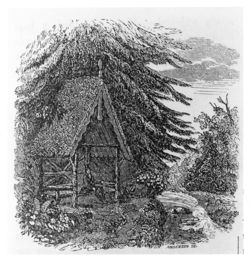
The second meaning of the term referred to a covered sitting and viewing area that was either attached to the building or was free-standing. In describing the use of porches as "decorative marks to the entrances of scenes" (akin to those of a theater proscenium), J. C. Loudon was referring to their use as embellished shelters over benches or seats placed in the garden. Downing's description of the rustic porch at Montgomery Place, on the Hudson River in Dutchess County, N.Y., argues that in addition to punctuating or shaping garden scenery, as Loudon recommended, porches, if appropriately placed and decorated, offered a way to situate a seat in the landscape thereby directing a view or prospect [Fig. 12]. Its function also allowed those seated to observe the landscape in all kinds of weather, as described in 1749 by Pehr Kalm. Downing's porches make clear the function of the porch as a mediator between interior and exterior realms. He praised porches that were covered with vegetation for easing the transition from outside to inside, and for providing evidence of the cultivated domesticity within the home [Fig. 13].
The third kind of porch is described by Downing as the carriage porch, or porte cochre, where in a grand home the arriving guests drew up under an architectural canopy for shelter. John Notman similarly inscribed the term porte cochre on his unexecuted design for the Smithsonian Institution in Washington, D.C. [Fig. 14]. He includes porches for the side entrances and piazzas for galleries running along the façades.
The term "portico" was also used when referring to a covered space that was supported by columns or piers and was attached to a building. Semantic distinctions were made, however, using "portico" to identify the principal entrances to the house and "piazza" for the extended side porches. The higher status of the portico, as opposed to piazza, veranda, or porch, was emphasized by its frequent modification by adjectives such as "handsome," "noble," and "elegant" [Fig. 15]. The word "portico" seems not to have been used to refer to covered walkways that linked separate buildings, as is made clear in the distinction in 1777 regarding the College of William and Mary in Williamsburg, Va.

Margaret Bayard Smith in 1828 said the portico at President James Madison's plantation, Montpelier, commanded a view, "a beautiful scene," of extensive lawns and forests, where viewers walked through the portico until twilight when the landscape was no longer visible [Fig. 16]. John Mason recalled the portico at George Mason's Gunston Hall, near Mason Neck, Va., from which "you descended directly into an extensive garden." Downing's 1849 comments conveyed a similar meaning, suggesting that the portico served to connect the building, visually and also physically, "by gradual transition with the ground about it."

The portico served as a focal, as well as a viewing, point. Lewis Miller, for example, in 1849 wrote that at Mount Vernon the "lofty portico . . . has a pleasing effect when viewed from the water" [Fig. 17]. Often the portico was distinguished from the building it ornamented by its material, creating a distant focus for the spectator from the garden or surrounding landscape. A brick building was sometimes ornamented with a contrasting white stone or painted wood portico. As David Bailie Warden noted in 1816, such a feature made a house "admirably adapted to the American climate."

Porticos generally were dressed in a classical style, meaning that classical columns supported the low-pitched roof and the front was finished with an entablature and pediment. Many descriptions specified Doric (e.g., Centre Square in Philadelphia), Tuscan (e.g., the Woodlands near Philadelphia), or Corinthian (e.g., Ranlett's design for a house in Italian bracketed style). Two notable exceptions to the classical style, however, are well known. William Buckland's fanciful octagonal porch at Gunston Hall (1755-58) had ogee arches and is thought to have been inspired by the writings of Batty Langley, who promoted Gothic and chinoiserie details for architectural decoration [Fig. 18]. Benjamin Henry Latrobe's Gothic design for Sedgeley, near Philadelphia (1799) [Fig. 19], which is considered one of the earliest Gothic revival houses in America, had tall slender posts supporting the roof.
Thus, two points are important in the history of these terms: First, these architectural elements served to elide the boundaries of the garden and building by linking interior and exterior space both visually and physically. Second, the associative values of refinement and domesticity, and even national progress, were read into the forms. --Therese O'Malley
Texts
Usage
- Anonymous, June 21 1706, describing in the Journals of the House of Burgesses construction resolutions in Williamsburg, Va. (Colonial Williamsburg Foundation; hereafter CWF)
- "Ordered That ye said Henry Cary do cause the pavements in ye Piazza to be taken up, and new Laid, and yt [sic] the well be filled up and the pavement of ye walk Leading thereby finished."
- Jones, Hugh, 1722, describing the College of William and Mary, Williamsburg, Va. (1956: 66-67)[7]
- "At the north end runs back a large wing, which is a handsome hall . . . there is a spacious piazza on the west side, from one wing to the other. It is approached by a good walk, and a grand entrance by steps, with good courts and gardens about it."
- Anonymous, 1756, describing in the Virginia Gazette the construction materials needed for the Capitol, Williamsburg, Va. (quoted in Lounsbury 1994: 298)[8]
- "Wanted about 280 feet of purbeck and 80 feet of balne shrosberry stone for completing the piazzas of the capitol in Williamsburg."
- Anonymous, October 13, 1757, describing a property for sale in Charleston, S.C. (South Carolina Gazette) [8]
- "on a Creek fronting Charles-Town, with a neat pleasant-situated House thereon, having Piazzas South, West and North, and being about 6 Miles from Charles-Town."
- Iredell, James, 1773, describing Edenton, N.C. (quoted in Lounsbury 1994: 269) [8]
- "Spoke to Mr. Jones in his Piazza, walked with him in his Garden, but was not asked in to his house."
- Attmore, William, 1787, describing New Bern, N.C. (quoted in Lounsbury 1994: 269)[8]
- "there are to many of the houses Balconies or Piazzas in front and sometimes back of the house, this Method of Building is found convenient on account of the great Summer Heats here."
- Cutler, Rev. Manasseh, July 14, 1787, describing Gray's Tavern, Philadelphia, Pa. (1987: 1:274)[9]
- "From this grass plat we went into a piazza one story high, next the street, very pleasant, as it is in full view of the river."
- Anonymous, December 24, 1799, describing in the Virginia Gazette a property for sale in Richmond, Va. (CWF)
- "For sale: A house on Shockoe Hill near the Capitol in Richmond. . . . Adjoining this building is a kitchen, laundry, office, coachhouse to hold two carriages, lodging rooms for domestics. This building is connected to the house by a double piazza."
- Sibley, Dr. John, September 15, 1802, describing the plantations along the Mississippi River, in the vicinity of New Orleans, La. (1927: 477)[10]
- "The houses all after the same fashion, one story, wood, large on the ground, a Hall & 4 chambers, piazzias on all Sides and almost all painted white."
- Cutler, Rev. Manasseh, November 22, 1803, describing the Woodlands, seat of William Hamilton, near Philadelphia, Pa. (1987: 2:144)[9]
- "Near the point of land a superb but ancient house built of stone is situated. In the front, which commands an extensive and most enchanting prospect, is a piazza, supported on large pillars, and furnished with chairs and sofas, like an elegant room."
- Birch, William Russell, 1808, describing York Island, Long Island, N.Y. (n.p.)[11]
- "This view is taken from the piazza of the seat of General Stevens on Long Island, near that extraordinary channel called Hell-gate, on the East river, or sound. The view was taken in the morning at the rising of the sun, when a glow of light from the arch of Heaven, exhibited to the view almost innumerable seats, spreading over an extensive country which glittered as the sun arose, like so many stars in the firmament, upon the face of this beautifully variegated Island. The scene extending [sic] across the North river to the Jersey shore." [See Fig. 1]
- Jefferson, Thomas, March 1, 1808, describing Mount Vernon, plantation of George Washington, Fairfax County, Va. (quoted in Stein 1993:100)[12]
- "My green house is only a piazza adjoining my study, because I mean it for nothing more than some oranges, Mimosa Farnesiana and a very few things of that kind."
- Ramsay, David, 1809, describing Charleston, S.C. (1858: 130)[13]
- "A passion for flowers has of late astonishingly increased. Many families in the capital, and several in the country, for some years past have been uncommonly attentive to flower gardens. Those who cannot command convenient spots of ground have their piazzas, balconies, and windows richly adorned with the beauties of nature far beyond anything that was known in the days their infancy."
- Martin, William Dickinson, May 13, 1809, Moore's Old Ordinary, Halifax, County, Va. (CWF)
- "We breakfasted this morning at a house much celebrated in Virginia, called Moore's old Ordinary. It was decidedly superior to any public house, we had yet stopt at on our Route . . . it was now morning, and many of the young people who remained where seated, or walking for their amusement in the cool shade of a long piazza, enjoying the morning breezes."
- Peale, Charles Willson, July 22, 1810, in a letter to his son, Rembrandt Peale, describing Belfield, estate of Charles Willson Peale, Germantown, Pa. (Miller, Hart, and Ward, eds., 1991: 3:54-55)[14]
- "I have marked the ends of some Joice between the windows, from these I intend to make a Piazer extending round the south End. at the X is a fine spring runing out of a Rock—at this I shall make a spring House & perhaps a Mill."
- Smith, Margaret Bayard, Summer 1811, describing Smith's summer retreat, Sidney, near Washington, D.C. (1906: 87)[15]
- "I had a table with benches round it in the front Piazza, to which we removed after dinner to eat our desert [sic]."
- Lambert, John, 1816, describing Beaufort, S.C.(2:207)[16]
- "One peculiarity, however, may be remarked respecting them, which is, that piazzas are generally attached to their southern front, as well for the convenience of walking therein during the day, as for preventing the sun's too great influence on the interior of the house."
- Watson, Joshua Rowley, June 13, 1816, describing Eaglesfield, country house of Robert Egglesof Griffith, Philadelphia, Pa. (quoted in Foster 1997: 290)[17]
- "You enter the house from a Piazza 25 feet long, with a porch in a half circular form, supported by pillars, into the hall. . . . The front windows of the eating & drawing rooms reach from near the top of the room to the floor, and open out on a spacious Piazza 46 ft long and 13 ft wide supported by 6 pillars, the whole front of the house. . . . Near the house is a pavilion with a Piazza all round it, it consists of two rooms and well situated for privacy."
- Watson, Joshua Rowley, June 17, 1816, describing Belmont Mansion, estate of Judge William Peters, near Philadelphia, Pa. (quoted in Foster 1997: 292-93)[17]
- "Bellmont house is old, but is well built of stone and like all the Country houses, has a Piazza in front. I don't see why those in England should not have the same, which would secure a fine airy walk in all weathers, besides being ornamental to the building."
- Latrobe, Mary Elizabeth, April 18, 1820, describing the home of Benjamin Henry Latrobe, New Orleans, La. (1951: 181)[18]
- "Our lot is 360 feet and 64 front, the house is up 16 steps with a Piazza (or Gallery as they call them here) the whole length of the house front and back, there is no entry or passage like our Baltimore houses."
- Watson, John Fanning, 1822-23, describing Cape May, N.J. (1857: 2:541)[19]
- "Among our few amusements—we swing—gather curious shells and pebbles upon the strand—walk the piazza, and converse.
- Hall, Capt. Basil, 1828, describing a plantation he visited during his trip from Charleston, S.C., to Savannah, Ga. (quoted in Jones 1957: 98) [20]
- "From the drawing-room, we could walk into a verandah or piazza, from which, by a flight of steps, we found our way into a flower garden and shrubbery."
- Trollope, Frances Milton, 1828, describing Cincinnati, Ohio (1832: 1:147)[21]
- "Our cottage had an ample piazza, (a luxury almost universal in the country houses of America), which, shaded by a group of acacias, made a delightful sitting-room."
- Du Pont, Sophie Madeleine, August 9, 1829, describing Eleutherian Mills, estate of Eleuthère Irénée du Pont, near Wilmington, Del. (quoted in Low and Hinsley 1987: 93)[22]
- "Our new deer, Fanny, is very annoying—She is constantly on the piazza, and seizes every opportunity of rushing into the house, and what is worse, is so tame that there is no frightening her away—Azor encouraged by her example, is almost always on the piazza, and if any thing is left on the entry windows, they seize & devour it—if not, they knock it down." [Fig. 20]
- Say, Thomas, October 19, 1830, describing his residence in New Harmony, Ind. (Stroud 1992: 227)[23]
- "In summer, hummingbirds, sometimes three or four at a time, visited the honeysuckle that 'clustered' over his 'piazza.'" [Fig. 21]
- Thacher, James, December 3, 1830, "An Excursion on the Hudson," describing Hyde Park, seat of Dr. David Hosack, on the Hudson River, N.Y. (New England Farmer 9: 156)
- "The mansion house at Hyde Park is elevated about 200 feet above the surface of the river. With its two wings it presents a noble front of 136 feet, and is two stories above the basement. The centre or principal building, has a piazza on both fronts; the west front is open to the Hudson, and the east looks over a spacious, beautiful lawn towards the turnpike from New York to Albany."
- Bryant, William Cullen, June 19, 1832, describing Jacksonville, Ill. (1975: 346-47) [24]
- "The dwelling was of the most wretched description. It consisted of but one room about half of which was taken up with beds and cribs. . . . In an enormous fireplace blazed a huge fire . . . the hostess and her daughter were busy in cooking a supper for several travellers who were sitting under a kind of piazza in front of the house or standing in the yard. . . . About eleven preparations were made for repose. . . . The floor of the piazza was also occupied with men wrapped in their blankets."
- Ingraham, Joseph Holt, 1835, describing a sugar plantation near New Orleans, La. (1:80-81, 231, 243)[25]
- "The house was quadrangular, with a high steep Dutch roof, immensely large and two stories in height. . . . [It was] built of wood, painted white, with Venetian blinds, and latticed verandas, supported by slender and graceful pillars, running round every side of the dwelling. . . . At each extremity of the piazza was a broad and spacious flight of steps, descending into the garden which enclosed the dwelling on every side. . . .
- "Around the semi-circular flight of steps, ascending to the piazza of the dwelling,—the columns of which were festooned with the golden jasmine and luxuriant multiflora,—stood, in large green vases, a variety of flowers . . . breathing gales of fragrance upon the air. From this point the main avenue branches to the right and left, into narrower, yet not less beautiful walks, which, lined with evergreen and flowering shrubs, completely encircled the cottage. . . .
- "Passing from this plantation scene through the airy hall of the dwelling, which opened from piazza to piazza through the house, to the front gallery, whose light columns were wreathed with the delicately leaved Cape-jasmine, rambling woodbine and honeysuckle, a lovelier and more agreeable scene met my eye. I stood almost embowered in the foliage of exotics and native plants, which stood upon the gallery in handsome vases of marble and China-ware. The main avenue opened a vista to the river through a paradise of althea, orange, lemon, and olive trees, and groves and lawns extended on both sides of this lovely spot, 'Where Flora's brightest broidery shone,' terminating at the villas of adjoining plantations."
- Martineau, Harriet, 1835, describing Jamaica Pond, vicinity of Boston, Mass. (1838: 2:182-83)[26]
- "A cottage on Jamaica Pond, for instance, within an easy ride of Boston, is a luxurious summer abode. I know of one unequalled in its attractions, with its flower-garden, its lawn, with banks shelving down to the mere; banks dark with rustling pines, from under whose shade the bright track of the moon may be seen, lying cool on the rippling waters. A boat is moored in the cove at hand. The cottage itself is built for coolness, and its broad piazza is draperied with vines, which keep out the sun from the shaded parlours."
- Martineau, Harriet, 1835, describing the University of Virginia, Charlottesville, Va. (1838: 1:200)[26]
- "After the service we walked to the University, at the distance, I think, of a little more than a mile from the town. The singular ranges of college buildings are visible from a considerable distance, as they advantageously crown an eminence, presenting the appearance of a piazza surrounding an oblong square, with the professors' houses rising at regular intervals. We found that the low buildings connecting these larger dwellings were the dormitories of the students; ground-floor apartments opening into the piazza, and designed to serve as places of study as well as sleep." [See Fig. 7]
- Martineau, Harriet, 1835, describing life in the southern United States (1838: 1:219)[26]
- "You are then invited to see the house, learning by the way the extent and value of the estate you are visiting, and of the 'force' upon it. You admire the lofty, cool rooms, with their green blinds, and the width of the piazzas on both sides [of] the house, built to compensate for the want of shade from trees, which cannot be allowed near the dwelling for fear of moschetoes [sic]."
- Hovey, C. M., November 1839, "Notices of Gardens and Horticulture, in Salem, Mass," describing Elfin Glen, residence of P. Dodge, Salem, Mass. (Magazine of Horticulture 5: 404)
- "The cottage stands near the road, and is entered from the west front; on the south end is a piazza; the drawing-room opens into this, and thence into the garden to an open space, answering somewhat the purpose of a terrace, neatly gravelled."
- Franklin Fire Insurance Company, December 20, 1839, describing Laurel Hill Cemetery, Philadelphia, Pa. (quoted in Greiff 1979: 57)[27]
- "A two Story Stone Building With An Arch Way for an Entrance to Laurel Hill Cemetery from the Ridge Road.
- "Dimensions: The Whole front including the Arch is 68 feet; to wit, in the Centre is the Arch 12 feet Span, On each Side of the Arch Way is an Arch Piazza. Across the building 9 feet wide, the remaining 19 feet on each side of said arches is divided into lodge rooms, 2 each Story at each Side: the Width of Building 26 1/2 feet with a Piazza on each Side Whole length of the Building; The Piazza in front next to the Road is 10 feet Wide the One next to the Cemetery is 8 feet wide. The front Piazza has 4 round frame Pillars in front on each side of the Arch. . . . The floors to all the Piazzas are faced Sand Stone; The Piazza under the building on each side of the Entrance has 4 round Pillars . . . the Arches over the Piazzas along side of Entrance made in the same way & having block Cornices. There is a cast iron & a wooden laticed Gate to Entrance & a double panel door in front to each Piazza by the side of the large Arch, plain jambs painted & sanded: there is a similar door way at the other end of said Piazzas (but no doors hung) with panel jambs . . . from each Piazza by the Side of the Arch there is an entrance Door Midway to the lodge rooms 1st Story which leads directly to a Straight Boxed Stairway to 2nd Story."
- Barber, John Warner, and Henry Howe, 1841, describing Jefferson Barracks, Sacketts Harbour, N.Y. (p. 211)[28]
- "The two long ranges of buildings in the distance, facing the spectator, are the officers' quarters. The buildings at each end are the soldiers' barracks. These structures are of limestone ... with neat piazzas in front, forming three sides of a square, on which is the parade ground."
- Hovey, C. M., November 1841, "Notes made during a Visit to New York, Philadelphia, Baltimore, &c.," describing the residence of James Dundas, Philadelphia, Pa. (Magazine of Horticulture 7: 420)
- "The conservatory as well as the drawing- room, opens into a piazza."
- Buckingham, James Silk, 1842, describing Red Sulphur Springs, Va. (CWF)
- "One of these [ranges of chambers] is called "Bachelor's Room", as it consists only of single rooms, not more than twelve feet square, with a door letting in immediately from the public piazza, up and down which everybody walks, so that the door cannot be opened without the whole interior of the room being exposed. Each of these has two windows, less than two feet square, one opening into the piazza, and the other against the rock of the hill beyond."
- Bryant, William Cullen, March 6, 1843, describing Charleston, S.C. (quoted in Clarke 1993: 2:150)[29]
- "The city of Charleston strikes the visitor from the North most agreeably. He perceives at once that he is in a different climate. The spacious houses are surrounded with broad piazzas, often a piazza to each story, for the sake of shade and coolness, and each house generally stands by itself in a garden planted with trees and shrubs, many of which preserve their verdure through the winter."
- Evans, Charles, 1846, describing Friends Asylum for the Insane, near Frankford, Pa. (p. 10) [30]
- "At the termination of a gravel walk leading directly from the house through these two gardens, at the distance of about three hundred feet, is an ornamental house, surrounded on all sides by a piazza, fitted up as a library and reading room, and containing numerous specimens of natural history, maps, drawings, &c., &c., affording a most agreeable resort for such patients as may be considered by the physician well enough to enjoy it."
- Notman, John, December 26, 1846, describing his designs for the Smithsonian Institution, Washington, D.C. (quoted in Greiff 1979: 117)[27]
- "No. I, is the ground plan. . . . On both sides or fronts of the building where strong direct light is neither desirable nor necessary, piazzas are made within the line of walls, forming four sheltered ambulatories or cloisters, each 90 feet long by 10 feet wide; they are also passages from one point to another. . . .
- "The halls, corridors, piazza, and porches, [are] to be paved." [See Fig. 4]
- Anonymous, August 1848, describing Riversdale, estate of George and Rosalie Stier Calvert, Prince George's County, Md. (American Farmer 4: 53)
- "The main building is 68 by about 50 feet, with an elegant ''Portico'' on its northern [front], and a Piaza [sic], running its entire length, on its southern front, each constructed with due regard to classic and architectural propriety."
- Jones, Rev. C. C., June 5, 1851, in a letter to his wife, Mary Jones, describing Hermitage, estate of Andrew Jackson, Nashville, Tenn. ([1851] 1976: 175)[31]
- "The carriage drew up at the piazza, resembling the Mount Vernon piazza, paved with limestone flags, and with the fluted columns running to the cornice above the second story."
Citations
- Chambers, Ephraim, 1741-43, Cyclopaedia (2:n.p.)[32]
- "PIAZZA, in building, popularly called piache, an Italian name for a portico, or covered walk, supported by arches. See PORTICO.
- "The word literally signifies a broad open place or square; whence it also became applied to the walks or portico's around them. . . .
- "PORTICO, in architecture, a kind of gallery on the ground; or a piazza encompassed with arches supported by columns, where people walk under covert. See PIAZZA."
- Ware, Isaac, 1756, Complete Body of Architecture (p. 31)[33]
- "PORTICO.
- "A place for walking under shelter, raised with arches, in the manner of a gallery. The portico is usually vaulted, but it has sometimes a soffit, or ceiling. The ''portico'' is a piazza encompassed with arches raised upon columns, and covered over head in any manner."
- Prince, William, 1828, A Short Treatise on Horticulture (pp. 145-46)
- "Sweetbriar, or Eglantine.—This delightful species of the rose family is well calculated to train against the sides of houses, or up the pillars of the piazza, or to intermingle with the vines which entwine bowers, &c."
- Webster, Noah, 1828, An American Dictionary of the English Language (n.p.)[34]
- "PIAZ'ZA, n. [It. for plazza; Sp. plaza; Port. praça, for plaça; Fr. place; Eng. id.; D. plaats; G. platz; Dan. plads; Sw. plats.]
- Teschemacher, James E., May 1. 1835, "On Horticultural Architecture" (Horticultural Register 1: 159)
- "The piazzas of many houses are formed by a continuation of the roof supported by thick pillars, which give them a heavy appearance; those in the drawing are intended to represent piazzas, with concave roofs formed of painted floor cloth, fastened on slight wooden rafters, cut with curve desired, then supported by slender pillars connected by wooden arches with open work; such pillars may be quickly encircled by hardy climbing plants." [Fig. 22]
- Webster, Noah, 1848, An American Dictionary of the English Language (p. 824)[35]
- "PI-AZ'ZA, n. [It. for plazza; Sp. plaza; Port. praça, for plaça;; Fr. place; Eng. id.; D. plaats; G. platz; Dan. plads; Sw. plats.]
- "2. In Italian, it denotes a square open space surrounded by buildings. Gwilt."
- Ranlett, William H., 1851, The Architect ([1851] 1976: 14, 16-17, 32, 38, 39)[36]
- "The design given in this part of the Architect, number XXVI., is the plan of a Villa in the Anglo-Italian style, now in process of erection on the south side of Lake Ontario, in the city of Oswego. . . .
- "ROOFS, CORNICE, &c. . . . The first section of main roof to be covered with first quality 3 feet cedar shingles, laid three thick on hard-wood lath; the roofs of the top section, the two wings, the piazza, porticos, bay and oriel windows, covered with tongued and grooved plank, and overlaid with 'Naylor's patent tinned iron plates,' with ridge joints. . . . principal portico and piazza roofs to be supported by eight round fluted Corinthian columns, with carved caps and turned bases . . . the ceiling of the portico and piazza, of narrow, clear boards; the filling below the several floors of piazza, gallery and veranda to be open work.
- "On the south is a flat-roofed piazza, with open balustrade railing, supported by Corinthian columns. . . . [Fig. 23]
- "the absence of a piazza, the lack of all ornamentation, of vines and shrubbery [of a house recently erected in the suburbs of N.Y.], bespeak a degree of ignorance of the means of enjoyment, of niggardliness and contracted views, that ere long will be looked upon with incredulity."
Images
Inscribed
Batty Langley and Thomas Langley, Four Examples of Arcades for Piazza's [sic], in Gothic Architecture, Improved by Rules and Proportions in many Ground Designs (1747), pl. 29.
Samuel Vaughan, Plan of Bath (Berkeley Springs), Va., 1787. Plan lists "bb" as "two Piazzas with seats".
Charles Bulfinch, "Joseph Barrell House remodeled as McLean Hospital", 1817. Plan includes a "covered piazza" on either side of the upper terrace.
Robert Mills, Design for the Joseph Hand Villa, 1807. A piazza is included on the principal story.
Charles Willson Peale, Letter to Angelica Peale describing his garden at Belfield, November 22, 1815.
Charles Willson Peale, Sketches of Belfield, 1810.
Samuel Vaughan, Plan of the buildings and grounds of Mount Vernon, 1787.
Associsted
William Russell Birch, "York-Island with a View of the Seats of Mr. A. Gracie, Mr. Church &c.", 1849.
Notes
- ↑ William Pierson, Jr., traces the origins of the feature, specifically found in Alexander Jackson Davis and A. J. Downing's work, to the awning or canopy partaking of an oriental flavor. In general, its origin was a semi-enclosed outdoor space that was not at all architectural but was related to the ornamental canopy or tent. This connection might explain why the detail flourished during the high romantic period in American architecture. See Pierson, American Buildings and Their Architects: Technology and the Picturesque, the Corporate and the Early Gothic Styles, vol. 2 (New York: Doubleday, 1978), 300-304.
- ↑ Kalm, The America of 1750: Peter Kalm's Travels in North America, trans. and rev. Adolph B. Benson (New York: Wilson-Erickson, 1937), 121. In his study of the veranda, Anthony D. King wrote, "It is generally accepted that the term 'verandah,' as used in England and France, and later in the British colonial world, came into the English landscape from India, the origins being either Persian, or, more likely Spanish or Portuguese." See King, The Bungalow: The Production of a Global Culture, 2nd ed. (Oxford: Oxford University Press, 1995), 266.
- ↑ This, of course, was not true because the veranda was featured in both John Plaw, Sketches for Country Houses, Villas and Rural Dwellings (London: S. Gosnell for J. Taylor, 1800), and J. B. Papworth, Penny Cyclopaedia (London: J. Taylor, 1818), as pointed out by King, The Bungalow, 266-67.
- ↑ Vincent J. Scully, The Shingle Style and the Stick Style: Architectural Theory and Design from Downing to the Origins of Wright (New Haven, Conn.: Yale University Press, 1971), introduction.
- ↑ A. J. Downing, A Treatise on the Theory and Practice of Landscape Gardening (New York: G. P. Putnam, 1849), 370.
- ↑ William H. Pierson, Jr., American Buildings and Their Architects: Technology and the Picturesque, the Corporate and the Early Gothic Styles (New York: Doubleday, 1978), 302-4. See also King, The Bungalow, 267, where the author writes that "[a]n architectural note of the term, verandah," emphasized that "it was common as a fashionable architectural feature in England during the early nineteenth century," and does not recognize an American distinctiveness.
- ↑ Hugh Jones, The Present State of Virginia, From Whence Is Inferred a Short View of Maryland and North Carolina, ed. by Richard L. Morton (Chapel Hill, N.C.: University of North Carolina Press, 1956), view on Zotero.
- ↑ 8.0 8.1 8.2 8.3 Carl R. Lounsbury, ed., An Illustrated Glossary of Early Southern Architecture and Landscape (New York: Oxford University Press, 1994), view on Zotero.
- ↑ 9.0 9.1 William Parker Cutler, Life, Journals, and Correspondence of Rev. Manasseh Cutler, LL. D (Athens, Ohio: Ohio University Press, 1987), view on Zotero.
- ↑ John Sibley, "The Journal of Dr. Sibley July-October, 1802," Louisiana Historical Quarterly 10 (1927):474-497, view on Zotero.
- ↑ William Russell Birch, The Country Seats of the United States of North America: With Some Scenes Connected with Them (Springland, Pa.: W. Birch, 1808), view on Zotero.
- ↑ Susan R. Stein, The Worlds of Thomas Jefferson at Monticello, (New York: Harry N. Abrams, 1993) view on Zotero
- ↑ David Ramsay, Ramsay’s History of South Carolina, from Its First Settlement in 1670 to the Year 1808 (Newberry, S.C.: W. J. Duffie, 1858), view on Zotero.
- ↑ Lillian B. Miller and et al, eds.,The Selected Papers of Charles Willson Peale and His Family: Charles Willson Peale: Artist in Revolutionary America, 1735-1791 Vol. 1; Charles Willson Peale, Artist as Museum Keeper, 1791-1810. Vol 2, Pts. 1-2; The Belfield Farm Years, 1810-1820. Vol. 3; The Autobiography of Charles Willson Peale. Vol. 5. (New Haven, Conn.: Yale University Press, 1983-2000), view on Zotero.
- ↑ Margaret Bayard Smith, The First Forty Years of Washington Society, ed. by Gaillard Hunt (New York: Charles Scribner’s, 1906), view on Zotero.
- ↑ John Lambert, Travels through Canada, and the United States of North America in the Years 1806, 1807, and 1808, 2 vols. (London: Baldwin, Cradock, and Joy, 1816), view on Zotero.
- ↑ 17.0 17.1 Kathleen A. Foster, Captain Watson's Travels in America: The Sketchbooks and Diary of Joshua Rowley Watson, 1772-1818 (Philadelphia: University of Pennsylvania Press, 1997) view on Zotero.
- ↑ Benjamin Henry Latrobe. Impressions Respecting New Orleans: Diaries and Sketches, 1818–1820, ed. Samuel Wilson (New York: Columbia University Press, 1951), view on Zotero.
- ↑ John Fanning Watson, Annals of Philadelphia and Pennsylvania in the Olden Time; Being a Collection of Memoirs, Anecdotes, and Incidents of the City and Its Inhabitants, and of the Earliest Settlements of the Inland Part of Pennsylvania, from the Days of the Founders, 2 vols. (Philadelphia: E. Thomas, 1857), view on Zotero.
- ↑ Katharine M. Jones, The Plantation South (New York: Bobbs-Merrill, 1957), view on Zotero.
- ↑ Frances Trollope, Domestic Manners of the Americans, 3rd edn, 2 vols. (London: Wittaker, Treacher, 1832), view on Zotero.
- ↑ Betty-Bright Low and Jacqueline Hinsley, Sophie du Pont, A Young Lady in America: Sketches, Diaries, & Letters, 1823-1833, (New York: Harry N. Abrams, 1987), view on Zotero.
- ↑ Patricia Tyson Stroud, Thomas Say: New World Naturalist, (Philadelphia:University of Pennsylvania Press, 1992), view on Zotero.
- ↑ William Cullen Bryant, The Letters of William Cullen Bryant vol. 1, ed. by William Cullen II Bryant and Thomas G. Voss (New York: Fordham University Press, 1975), view on Zotero
- ↑ Joseph Holt Ingraham, The South-west, 2 vols. (New York: Harper, 1835), view on Zotero.
- ↑ 26.0 26.1 26.2 Harriet Martineau, Retrospect of Western Travel, 2 vols. (London: Saunders and Otley, 1838), view on Zotero.
- ↑ 27.0 27.1 Constance Greiff, John Notman, Architect, 1810-1865 (Philadelphia: Athenaeum of Philadelphia, 1979), view on Zotero..
- ↑ John Warner Barber and Henry Howe, Historical Collections of the State of New York; Containing a general collection of the most interesting facts, traditions, biographical sketches, anecdotes, &c., relating to its history and antiquities, with geographical descriptions of every township in the state, (New York: S. Tuttle, 1841), view on Zotero.
- ↑ Graham Clarke, ed., The American Landscape: Literary Sources and Documents, 3 vols. (East Sussex, England: Helm Information, 1993), view on Zotero.
- ↑ Charles Evans, An Account of the Asylum, (Philadelphia: Joseph Rakestraw, 1846), view on Zotero.
- ↑ C. C. Jones, A Georgian at Princeton, ed. by Robert Manson Myers (New York: Harcourt Brace Jovanovich, [1851] 1976) view on Zotero.
- ↑ Ephraim Chambers, Cyclopaedia, or An Universal Dictionary of Arts and Sciences. . . .,5th ed., 2 vols. (London: D. Midwinter et al., 1741-43), view on Zotero.
- ↑ Isaac Ware, A Complete Body of Architecture (London: T. Osborne and J. Shipton, 1756), view on Zotero.
- ↑ Noah Webster, An American Dictionary of the English Language, vol. 1 (New York: S. Converse, 1828), view on Zotero
- ↑ Noah Webster, An American Dictionary of the English Language... Revised and Enlarged by Chauncey A. Goodrich.... (Springfield, Mass.: George and Charles Merriam, 1848), view on Zotero
- ↑ William H. Ranlett, The Architect, 2 vols. (New York: Da Capo, 1976), view on Zotero.
